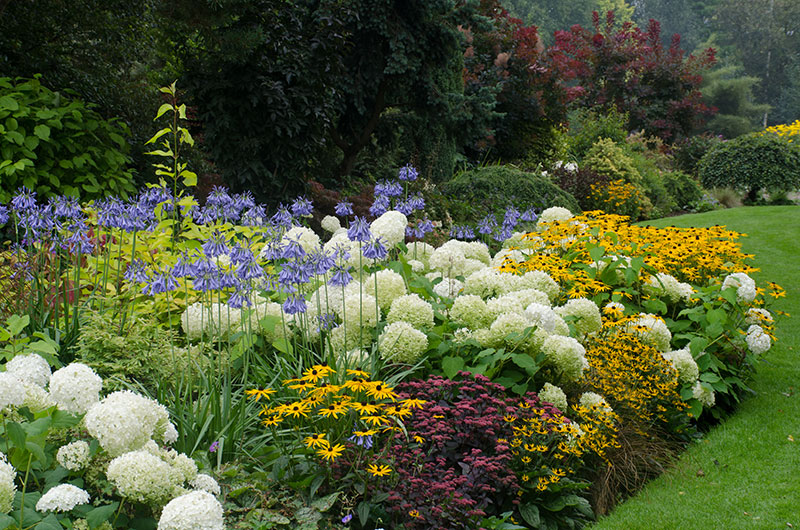|
As the fall months are in full swing, now is the perfect time to start planning what you would like to do with your landscape this coming spring. While that may seem months away, starting now gives you the necessary time to sketch out ideas, research costs and plan a budget, and find a professional to help you with the execution of your ideas. The following tips will help you get started.
Take measurements and map out your space. Before you start sketching out your ideas it is important to have a good understanding of what you have to work with. As best as you can, measure the dimensions of your space and map out where critical items are located, such as irrigation lines, gas or power lines, and key structural items like retaining walls, support beams, etc. While some of these items can be moved or altered, how you work around them could have a significant impact on your budget. In addition, having accurate measurements of your space will help you determine the scale of items that will work in your space so you don’t plan for something you might later regret. Decide on a style and research materials. One of the fundamental principles of creating an enjoyable space is harmony between all elements. Mixing too many styles together can make a landscape feel disjointed and thrown together. However, when your landscape features and plantings complement your home’s structure and stay within a set palette or style, you can achieve that harmonious aim and create a space you will enjoy living in for years to come. Determine your budget. Oftentimes homeowners underestimate the cost of their landscaping projects. Many times we see wishlists from clients with all of the features they want included, sometimes with sample products and costs included, but more times than not, clients forget to add in budget for design, labor, electrical, irrigation, or any padding for contingency. There is no one set dollar amount for a wooden deck, new pool, landscape renovation, etc. as every property and homeowner’s wishes are unique. But, you can get a rough ballpark of what a project might cost by consulting with your bank if you’re taking out a loan or by looking online at annual survey publications that provide national averages. Hire a professional. We fully support the DIY movement but there are some things in life where hiring a professional just makes sense. Landscaping is more than trees and grass so having a team on your side who understands and can anticipate the different elements involved with your project will save you time and money. Plus, when you hire a professional landscaping company the work should come with a guarantee — something you likely won’t get if you do tackle the project yourself and things go wrong. At Graham Landscape & Design, we have specialized teams of experts who can work with you through every step of your project, from the initial idea to the complete installation. We can even help you with ongoing maintenance so your project is as beautiful as it was on day one. Give us a call today to discuss your project. 541-729-8029
0 Comments
One of the best times of the year to introduce new plantings to your yard is the fall — the soil is still warm, creating faster root growth and plants get a head start on next year's growth. In addition, by next summer, your plants will have larger, more established root systems which will help them to be more drought-tolerant, and they'll produce better flowers in their first year.
Perennials If your summer annuals are looking tired or overgrown, there are a number of late-season flowers that can really brighten up your yard. A few great choices include asters, daisy-style plants, yarrow, and salvias. Because the middle of fall has more mild temperatures, these plants tend to do really well. Something you might not know, however, is that the majority of cold-hardy perennials thrive with fall plantings because their root systems grow all winter and emerge in the spring, ready to blossom! But, if you have poorly drained soil, you may want to wait until spring to plant perennials that require good drainage, such as lavender. If you're into bulbs, it is also time to get them in the ground! Daffodils, hyacinths, tulips, alliums, crocus, and many other varieties planted now will make for a great display next spring. If you want a little color while you wait, you can plant pansies in your flower beds around where the bulbs will sprout. Vegetables If you enjoy vegetable gardening, late August or early September is a time to start a fresh round of cool-season and overwintering crops. Varieties you can plant now include lettuce, spinach, other greens, broccoli, cauliflower, garlic, and onions. Your Lawn Late summer or early fall is also a great time for renovating your lawn. Dethatching is typically done this time of year, removing the dead matter underneath the growing grass and aerating the soil below. Doing this allows us to assess how full your lawn really is and if it needs to be reseeded, overseeded, or replaced with sod. Trees, Shrubs, and Fruit While these items can be planted other times throughout the year, the fall is best when the soil is softer and easier to dig, and the temperatures are also cooler. But, beware of caterpillar damage as that can be high in the fall. If you're not sure what to do with your yard or if this sounds like too much work to tackle on your own, please let us know. Our team of landscape experts can create for you a yard to enjoy all season long. Give the Graham Landscape & Design team a call at 541-729-8029. We are excited to launch our new website. Please visit often to see our projects in progress, samples of new techniques, news of our whereabouts, etc. Thanks for visiting!
-The Graham Landscape Crew |
OUR BLOG
Check here to see what we've been up to! Categories
All
|
|
|
Copyright © Graham Landscape Maintenance & Design LLC in Eugene Oregon. All rights reserved.
LCB # 8920 541-729-8029 34024 Old Willamette Hwy S., Eugene, OR 97405
Offering Landscape Design and Maintenance in Albany, Coburg, Corvallis, Cottage Grove, Eugene, Junction City, Roseburg, Springfield, Veneta and Surrounding Areas
LCB # 8920 541-729-8029 34024 Old Willamette Hwy S., Eugene, OR 97405
Offering Landscape Design and Maintenance in Albany, Coburg, Corvallis, Cottage Grove, Eugene, Junction City, Roseburg, Springfield, Veneta and Surrounding Areas


 RSS Feed
RSS Feed
